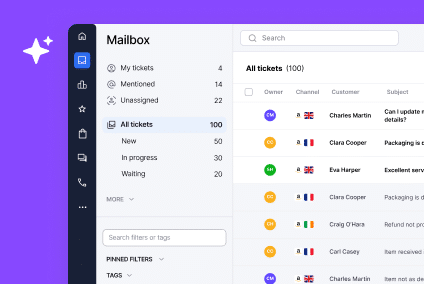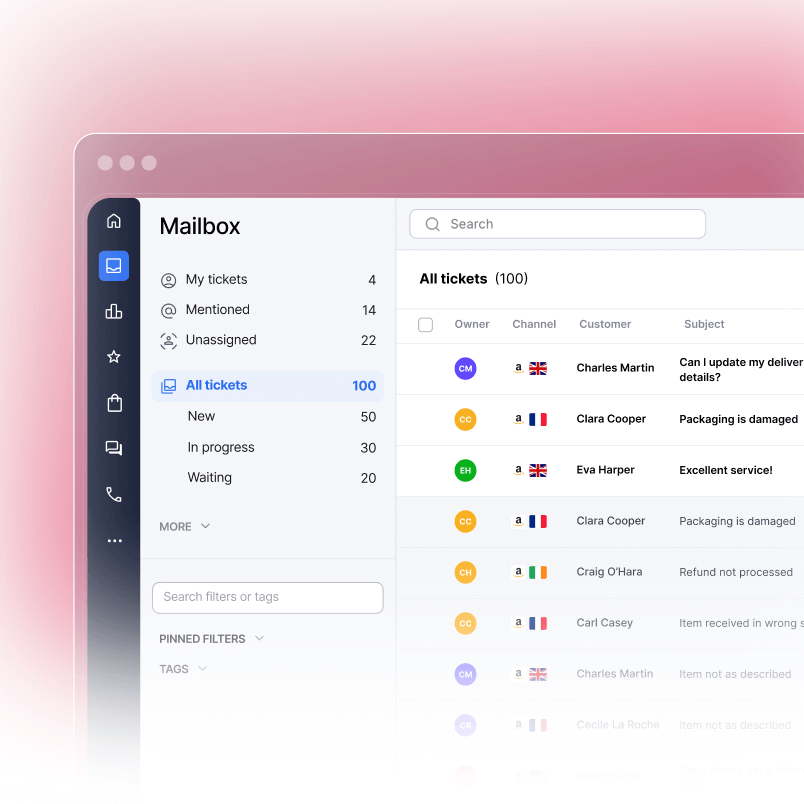Zendesk works fine for many businesses. But if you run an online store, you probably already know it feels clunky. You’re toggling between tabs. Your support team wastes time hunting for order details. Customer questions pile up while agents search through your ecommerce platform separately. Zendesk is a solid general helpdesk, but it wasn’t built for the speed and integration that online retail demands.
The truth is, ecommerce support runs differently. Your customers ask about orders, refunds, and products. They message you on Instagram, email, and chat. They expect you to see their purchase history without asking. Generic helpdesks make this harder, not easier.
We’ve put together this guide to show you why many ecommerce teams have moved away from generic helpdesks and what features actually matter for online stores. You’ll see exactly what separates purpose-built retail support tools from enterprise solutions and how to pick the right platform for your business.
The Problem with Generic Helpdesks for Ecommerce
Enterprise helpdesks are powerful. They’re also built for IT support, SaaS companies, and large organizations. When you use a tool designed for those industries, you get features you don’t need and miss the ones you do. 70% of consumers have bought from a business based on good customer service, and 41 percent of companies surveyed did not respond to customer service emails at all. Generic helpdesks make this problem worse, not better.
Generic Ticketing System, Not Optimized for Retail Workflows
Enterprise helpdesks treat every ticket the same. Whether someone’s asking about an invoice or a product defect, the system doesn’t know the difference. For ecommerce, this is a real problem. Your support team needs context fast. They need to pull up the customer’s order, see what they bought, check the status, and respond without jumping between windows. Generic systems make them do all that manually.
Weak Native Integrations with Shopify and BigCommerce
Enterprise helpdesks have basic Shopify plugins. They exist. They’re limited. Two-way syncing between your store and your support inbox isn’t built in. Historical order data doesn’t pull automatically. You end up with workarounds and manual steps that slow your team down and introduce errors.
Too Complex for Lean Ecommerce Teams
Enterprise helpdesks scale to handle thousands of support agents across multiple departments. That’s useful for big companies. For solo sellers or small teams running three to five Shopify stores, it’s overkill. The setup alone takes weeks. The pricing feels high for what you actually use. Your team spends more time configuring rules than helping customers.
Agent Friction Breaks Response Times
When your agents have to open multiple windows, then open Shopify, then check email separately to get context, response times tank. Customers wait longer. CSAT scores drop. Agents get frustrated with workflow friction. This isn’t a failure of your team. It’s a failure of the tool to fit the job. Only 13% of businesses fully carry customer context across channels, and 56% of customers say they have to repeat themselves during support interactions.
What Ecommerce Sellers Actually Need in a Helpdesk
Purpose-built ecommerce helpdesks solve these problems differently. Here’s what separates them from generic systems.
Real-Time Order Lookup and Visibility
When a customer emails « Where’s my order? », your agent clicks one button and sees the order history, payment status, and shipping info. No context switching. No manual searching. Best-in-class ecommerce companies respond to tickets within 2 minutes, and 90% of customers say a quick response is critical when they have a question.
Native Integrations with Shopify, WooCommerce, and BigCommerce
The helpdesk speaks your store’s language natively. Order syncing happens automatically. Product data flows into tickets. Customer purchase history is always visible. You avoid the API middleware and custom code that drain small teams’ resources.
Smart Macros Powered by Order and Product Data
Generic helpdesks let you save « Thanks for reaching out » templates. Ecommerce helpdesks go further. Macros can pull in the customer’s name, order number, product SKU, and shipping status automatically. Your team responds 10 times faster because the heavy lifting is done.
Omnichannel Support Out of the Box
Your customers message you on email, Instagram DMs, TikTok Shop, SMS, and your website chat. Managing these separately kills productivity. Ecommerce helpdesks unify all these channels into one inbox. Your team sees every message in one place and responds from one platform. Omnichannel service boosts customer satisfaction to 67%, compared to just 28% for disconnected multichannel, and companies with strong omnichannel engagement strategies retain an average of 89% of their customers versus 33% for weak strategies.
Built for Affordable, Scalable Pricing
Most ecommerce teams are lean. You don’t want to pay enterprise rates for helpdesk software. Ecommerce alternatives charge per user or offer flat plans that scale with your business, not against it.
Feature Comparison: Generic vs Ecommerce-Built Alternatives
| Feature | Enterprise Helpdesk | Ecommerce Helpdesk |
| Shopify Integration | Basic plugin, limited data sync | Native, deep two-way sync |
| Order Lookup in Ticket | Manual search required | Automatic, one-click access |
| Ecommerce Macros | Limited, generic templates | Built-in, product/order-aware |
| Live Chat & DM Support | Add-ons required | Native, unified inbox |
| Omnichannel (Email, IG, SMS, etc.) | Requires integrations | Built in, seamless |
| Pricing for SMBs | Tiered and expensive | Flat or flexible, scalable |
| Setup Time | Weeks | Hours to days |
| Learning Curve | Steep | Gentle for retail teams |
Top Ecommerce Helpdesk Solutions
Richpanel
Richpanel focuses on simplicity and fast implementation. It connects natively to Shopify and pulls full order context into conversations. Built-in AI helps your team draft responses faster. Omnichannel support includes email, chat, social media, and SMS. Richpanel works best for solo sellers and small teams who need fast setup without complexity.
Re:amaze
Re:amaze combines helpdesk, live chat, and knowledge base in one platform. Native Shopify and WooCommerce integration means your team has instant access to customer and order data. The tool handles email, chat, Instagram, Facebook, and SMS. Re:amaze works best for retailers who want an all-in-one solution without learning multiple tools.
DelightChat
DelightChat emphasizes team efficiency and conversation management. It pulls order and customer data natively from Shopify. Built-in macros and templates reduce response time significantly. DelightChat handles email, chat, Instagram, WhatsApp, and SMS in one inbox. It works best for brands managing high chat volumes and needing quick implementation.
Richpanel
Ecommerce-specific helpdesks like Richpanel are built from the ground up for retail. The platform handles email, chat, Instagram, Facebook, TikTok Shop, SMS, and more in a single inbox. Your team sees customer order data automatically in every ticket. Macros pull product info, order status, and customer history without manual entry. These solutions work best for growing DTC brands and Shopify stores scaling from 10k to 10M in annual revenue.
How to Migrate from a Generic Helpdesk Without the Headache
Moving helpdesk platforms feels risky. It doesn’t have to be.
Export Your Data from Your Current System
Most ecommerce helpdesks offer migration support. Start by exporting your ticket history, customer data, and any custom fields. Your current platform provides standard export tools. This takes a few hours depending on ticket volume.
Set Up Your New Ecommerce Helpdesk
Choose your platform and create your account. Most ecommerce helpdesks have onboarding teams that walk you through setup. This usually takes one to three days, not weeks.
Connect Your Store and Integrate Channels
Link your Shopify store or WooCommerce site. Connect your email, chat, social media, and SMS. Most platforms handle this in hours using simple authentication flows.
Import Historical Tickets and Macros
Upload your exported tickets so your team has historical context. Recreate or import your saved macros and canned responses. Your new system learns from your past workflows.
Train Your Team on the New Workflow
Most teams adapt within a week. The new platform is usually more intuitive than enterprise systems for retail work. Your agents will appreciate the faster workflows and less context switching.
Final Thoughts
Enterprise helpdesks are solid tools for many industries. But ecommerce is different. Your customers need fast support. Your team needs context instantly. Your workflow is centered on orders, products, and customer history. Generic helpdesks add friction to all three.
Ecommerce-built alternatives remove friction and help you deliver that positive experience consistently. Your team responds faster. Your customers get better support. Your CSAT scores improve. Most importantly, you avoid the cost and complexity of forcing an enterprise tool to work for your small or growing business.
The right helpdesk should fit your business, not the other way around. Try one of these ecommerce-focused alternatives today and see how much time your team gets back.
FAQs
Why isn’t an enterprise helpdesk ideal for ecommerce support?
Enterprise helpdesks are built for IT and general business support. They don’t prioritize order lookup, native store integrations, or omnichannel retail workflows. Your team ends up jumping between multiple apps to answer basic questions about orders and products.
What features should an ecommerce helpdesk have?
Real-time order lookup, native Shopify or WooCommerce integration, omnichannel support (email, chat, social media, SMS), smart macros that pull product and customer data, and affordable pricing designed for small teams.
How hard is it to migrate off an enterprise helpdesk?
Not hard. Most migrations take one to two weeks. You export your data, set up the new platform, connect your store and channels, and train your team. The process is straightforward and most ecommerce helpdesks offer migration support.
What’s the best helpdesk alternative for a small store?
For solo sellers or very small teams, solutions focused on simplicity and fast implementation offer the quickest setup and most intuitive workflows. Both are built for retail simplicity and cost less than enterprise systems. If you’re running multiple




